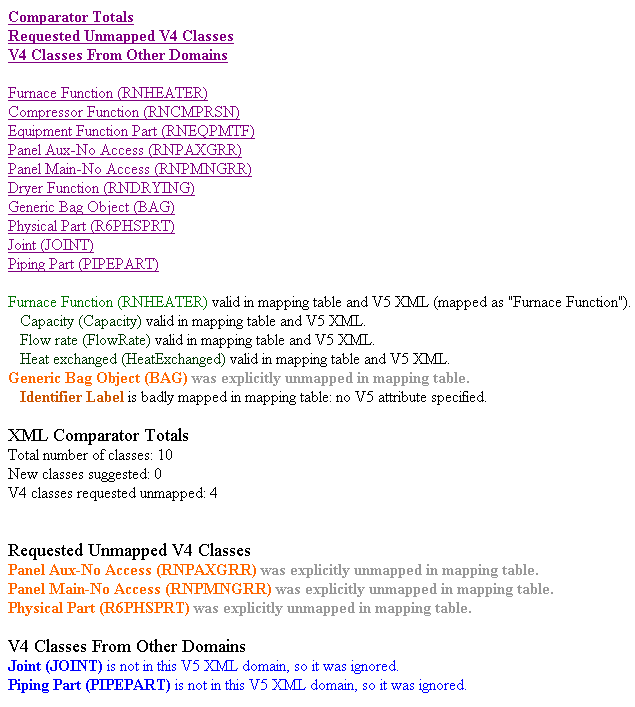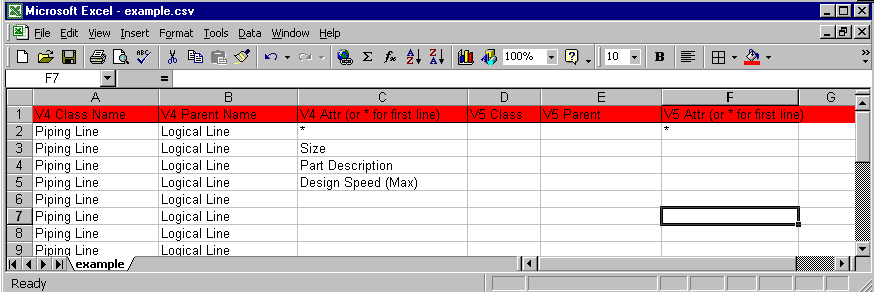Comparing the XML Output
| This task shows how to compare the V4 and V5 classes and attributes. This task should be performed after you have exported the V4 project registration model and the V5 feature dictionary. | ||
| Your goal is to have a mapping
table that shows the V4 classes and attributes you want to import and
their corresponding V5 classes and attributes. Once you have converted and
exported the V4 and V5 classes and attributes, the two must be compared to
determine which ones do not exist in V5. This is done by a tool developed
for the purpose. Once you have run this tool it will produce three files
which tell you: which classes have problems (do not exist in the mapping
table or the XML file of V5 classes), which classes need to be added to V5
and an overall report of what the tool has performed.
This step is not needed if you did not define new classes and attributes in V4. Before you begin this process you must set the directory path - this tells the tool the directory path in your installation. Open a command prompt and move to the directory intel_a\code\bin.
|
||
| 1. | To run the tool open a
command prompt, change to the directory ...intel_a\code\bin, and enter the
following: CATAecDictionaryComparator -i (V4file) (V5file) -m (name
of mapping table) -o (name for output)
Where:
An entry may look like this: CATAecDictionaryComparator -i Preg_ALL.xml catpiping.xml -m V4toV5ObjectMapping.csv -o MAR |
|
| 2. | When the tool (called Comparator) has finished running it
will produce three reports and place them in the following directories:
XML and CSV files in intel_a\startup\EquipmentandSystems\MigrationDirectory\Dictionary\DDL_Files
and the HTML file in ...\Reports.
Open the HTML file in a Web browser to see a full report. The report begins with a table of contents that is hyperlinked to the entries. (The names in parentheses are internal names.) The entries in the report are color coded as follows:
|
|
| 3. | Open the XML file (using a text editor like Wordpad) to see
a list of the classes that do not exist in the V5 feature dictionaries and
can be imported.
<Class Name="PipingPartFunc" DisplayName="Piping Part Function" Superclass="Component_Function" Creator="System" Domain="PIP" UUID="b7acacd1_83_3a707981_10"> |
|
| 4. | Open the CSV file using Microsoft Excel. It will look
similar to the image below, except that it will not have the entries shown
in the first line (shaded red).
In the first three columns this table displays existing classes in V4. You should fill in the 4th, 5th and 6th columns with whatever you want the corresponding entry to be in V5. In column 7 you should enter the domain, or application. (PIP=Piping Design, PID= Piping and Instrumentation Diagrams, EQT= Equipment Design, HVA=HVAC Design, etc.) An asterisk in the Attribute column indicates that the entry is a class. If it has attributes then the lines that follow it will list the attributes under the same class name. In the example above, Line 2 shows a class. Lines 3, 4 and 5 show that the entries are attributes of the class Piping Line and are called Size, Part Description and Design Speed. NOTE: V5 entries should refer to the internal name of the class or parent. The internal name is the name within the application and is not the one the user sees. Frequently it is similar, though, and the class name Piping Line may have the internal name PipingLine. You can find the internal name by looking at the V5 XML file where it's referred to as Name and Superclass. |
|
| 5. | Once you have entered the information you need to copy and
paste it into the mapping table - in the current example it is V4ToV5ObjectMapping.csv,
found in intel_a\startup\EquipmentandSystems\MigrationDirectory\Dictionary\MappingTable.
However, you should not directly modify the table the table with the .csv
extension. In this same directory you will find a table with the same
name but with the extension .xls. Modify this table, save it, and then
save it again as a .csv file also. It is faster for this application to
read .csv files.
|
|
| 6. | If you have V4 classes and attributes that do not have
equivalent classes and attributes in V5 then you must repeat the steps
explained in Importing the XML Output.
You can repeat these steps as many times as you want - until you are satisfied that your mapping table has all the V4 classes and attributes you want and the corresponding V5 classes and attributes. |
|
|
|
||


